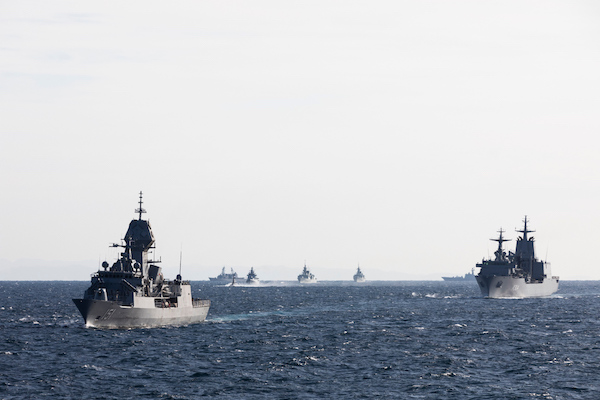Comments and Articles
AUKUS and the 2023 Defence Strategic Review – A turning point for the Royal Australian Navy

As an island nation, Australia’s sovereignty, security, and prosperity are intrinsically linked to its maritime surrounds and the uncontested and unrestricted access to the global maritime commons.
The 2020 Defence Strategic Update, recognised that military modernisation in the Indo-Pacific had accelerated faster than envisaged. Regional force modernisation has resulted in the development and deployment of new weapons that challenge Australia’s military capability edge. Expanding cyber capabilities, and the willingness of some countries and non-state actors to use them, are further complicating Australia’s strategic environment.
Confidence in the rules-based global order is being undermined by disruptions from a widening range of sources. Major power competition has intensified and the prospect of high-intensity conflict in the Indo-Pacific, while still unlikely, is less remote than in the past. And the conduct of ‘grey-zone’ activities has also expanded in the Indo-Pacific. These activities involve military and non-military forms of assertiveness and coercion aimed at achieving strategic goals without provoking conflict. In the Indo-Pacific, these activities have ranged from militarisation of the South China Sea to active interference, disinformation campaigns, and economic coercion.
In response to this deteriorating strategic environment, the Australian Government determined that it must be better prepared to respond to this situation. On 15 September 2021, the leaders of Australia, the United Kingdom, and the United States announced AUKUS – a new security partnership designed to promote a free and open Indo-Pacific that is secure and stable.
Recognising the common tradition of the three countries as maritime democracies, the first initiative adopted under AUKUS, was a commitment to a shared ambition to support Australia in acquiring nuclear-powered submarines for the Royal Australian Navy. What followed over the next 18 months was a trilateral effort to seek an optimal pathway to deliver this capability. On 14 March 2023, Australian Prime Minister Anthony Albanese, British Prime Minister Rishi Sunak and US President Joe Biden announced how Australia will build a nuclear-powered submarine capability under the AUKUS agreement.
Under the four-phase AUKUS plan, Australia has already started developing the capacity and know-how to build the professional force needed to operate and support a fleet of nuclear submarines. Australian military and civilian personnel have commenced embedding with the Royal and US navies, and US nuclear-powered submarines will increase their visits to Australian ports, with Australian sailors joining US crews for training. Phase Two will see American and British submarines operating on a rotational basis from Western Australia from 2027, with one UK Astute Class submarine and up to four US Virginia Class submarines rotating through HMAS Stirling. From the early 2030s, Phase Three will see the US sell Australia three Virginia Class submarines, with an option for two more. Then the final phase will be the production of the first Anglo-Australian-designed submarine, SSN-AUKUS.
The SSN-AUKUS program is set to constitute the backbone of the submarine force of both Australia and the UK for decades to come. A combination of UK submarine design and US technology will contribute to the development of the new SSN-AUKUS submarine. Both Australia and the UK intend to start building SSN-AUKUS submarines in their domestic shipyards before the end of this decade, with Australia commencing construction works on the shipyard required to build nuclear-powered submarines in Osborne, South Australia, this year.
The first of these boats may enter into UK service in the late 2030s, and it is planned that the Australian Navy will receive its first Australian-built SSN-AUKUS submarine in the in the early 2040s.
The Defence Structure Review
24 April 2023, saw the release of the public version of the Defence Strategic Review (DSR). Commissioned in the first 100 days of the new Labor Government, the DSR sets the agenda for ambitious, but necessary, reform to Australia’s defence posture and structure.
While separate from, but linked to, the AUKUS initiative, the DSR makes major recommendations about the force structure and capabilities of the Australian Defence Force. The DSR identifies itself as ‘the most substantial and ambitious approach to defence reform recommended to any Australian government since the Second World War’. It maps out a pivot for the national defence strategy from the defence of Australia, to the defence of Australian interests, or ‘national defence’.
Acquiring nuclear powered submarines through AUKUS to improve Australia’s deterrence capabilities takes number one priority. Other priority areas identified for immediate action include;
- developing the ADF’s ability to precisely strike targets at longer-range and manufacture munitions in Australia;
- improving the ADF’s ability to operate from Australia’s northern bases;
- initiatives to improve the growth and retention of the Defence workforce;
- lifting the capacity to rapidly bring disruptive new technologies into ADF capability, and;
- deepening diplomatic and defence partnerships with key partners in the Indo-Pacific.
While it was expected that the DSR would make recommendations about the future force structure of the Australian Navy, instead the government agreed to a DSR recommendation that an independent analysis of the navy’s surface combatant fleet capability should be conducted to ensure its size, structure and composition complement the capabilities provided by the forthcoming conventionally-armed, nuclear-powered submarines.
This review will be conducted by retired US Vice Admiral Willy Hilarides, Australia’s former Finance Secretary, Rosemary Huxtable, and former Australian Fleet Commander, Vice Admiral Stuart Mayer. While the review is not expected to be completed until September this year, the Australian Minister for Defence, Richard Marles, has already hinted at a major shakeup of the surface fleet. Minister Marles noted that with the switch to nuclear powered submarines, the currently envisioned fleet would need changes given it was designed to operate alongside diesel-powered submarines. He also commented on the DSR’s finding that Australia needs to embrace a two-tiered system of surface combatants.
The DSR articulates a need to raise the fleet’s lethality and identifies a requirement for Tier 1 and Tier 2 surface combatants. While the tiering categories of surface combatants is not strictly defined, a Tier 1 ship is a vessel capable of power projection – vessels similar to Australia’s Hobart Class destroyers and the future Hunter Class frigates. Whereas a Tier 2 ship would typically refer to a vessel of Corvette or OPV size, that is capable of presence operations, or operating as part of a Task Group. Tier 3 ships would typically be smaller patrol boats, similar to Australia’s current Armidale and Cape Class vessels.
The DSR calls for an ‘optimal mix’ of Tier 1 and Tier 2 surface combatants, consistent with a larger number of smaller surface vessels, capable of providing increased strike, air defence, presence operations and anti-submarine warfare. This would significantly increase the Australian Navy’s capability through a greater number of lethal vessels with enhanced long-range strike (maritime and land) and air defence capabilities, together with the ability to provide presence in Australia’s northern maritime approaches.
Notwithstanding the need and support for an expansion of the Australian Navy’s surface fleet, the greatest challenge in realising this capability will be expanding the navy’s uniformed workforce from its current size of just over 15,000 to the 21,000 people needed to man the future fleet. The DSR also identifies that the ‘Navy faces the most significant workforce challenges of the three services’. On top of this, the Australian government estimates the nuclear submarine program will need 20,000 jobs over the next 30 years, within the ADF, the domestic ship-building industry and the public service. The government forecasts 8,500 will be directly employed in Australia’s building and servicing of the submarines, including scientists, engineers, project managers, construction workers, electricians, fitters and builders.
Notwithstanding the outcomes of the Hilarides Review of the surface combatant fleet capability, 2023 will be remembered as the year that the Royal Australian Navy changed forever.
Vice Admiral Mike Noonan, RAN (Rtd)
Senior Fellow Athena Lab
Temas relevantes


Don't miss any updates
Subscribe to our free newsletter to keep informed about our latest updates and activities.
Subscribe




